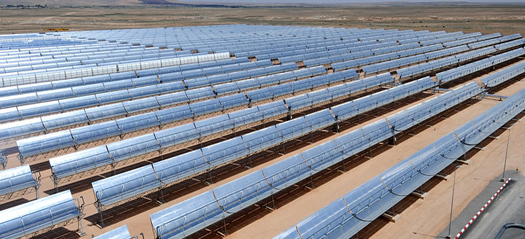
Ain Beni Mathar Integrated Combined Cycle Thermo-Solar Power Plant in Morocco. (Credit: Dana Smillie/World Bank)
International investment is pouring into Africa to help develop its climate resilience and renewable energy infrastructure. The UK announced 254MW worth of clean energy projects in South Africa, Canada partnered with the African Development Bank to tackle climate change through a gender equity lens, and China’s Belt and Road Initiative includes 46 African nations – all of these projects are aimed at developing the African continent, with varying levels of climate adaptation in mind
There are questions about the outcome of these projects – will they leave African nations in debt? Will they be too reliant upon energy sources that could fail amid a climate disaster? Investors and world leaders alike have their eyes on Africa.
Multiple reports have been published about Africa’s prime environment for renewable energy infrastructure, especially solar power. Much of the continent is already powered by hydroelectricity, but there is some speculation as to how climate disasters could affect the functionality of these systems.
The United Kingdom
UK Climate Investments, the UK’s International Climate Finance programme, recently completed Kruisvallei Hydro, a 4MW hydroelectric facility in the Free State Province, the last of three such projects in South Africa. The other two projects were wind farms, which the program also partly financed. The International Energy Agency’s report Climate Impacts on African Hydropower states, “Southern Africa is likely to experience a drier climate with more frequent incidences of low precipitation, while East Africa is predicted to experience a wetter climate with more frequent heavy rainfall. In addition to these future anomalies in climate patterns, the continent’s high sensitivity to water availability and its low adaptive capacity compound African hydropower’s vulnerability to climate change.” While hydroelectric systems do an excellent job of providing electricity to areas that did not previously have access, climate infrastructure projects must account for long-term shifts in resource availability or else investors may never recoup the costs of the project.
Canada
The African Development Bank and the Government of Canada have signed a deal aimed at tackling climate change with a strong gender-responsive component. The Canada-African Development Bank Climate Fund (CACF) provides concessional loans for climate projects that bolster women. As reported by the Africa Development Bank Group, “CACF resources will be deployed in innovative low-carbon technologies, renewable energy, climate-smart agriculture, sustainable forestry, water management, and climate-resilience projects.” Numerous reports about climate change elaborate upon the way women will be disproportionately affected. It is valuable to include women in adaptive strategic decision making as they have first-hand knowledge of the issues in their region.
China
China’s Belt and Road Initiative (BRI) has received extensive media coverage for its unprecedented scale but has also been heavily criticized for what some call its “debt-trap diplomacy,” indebting countries that have little hopes of paying and then using that debt to leverage political influence. The BRI includes 46 African countries, and while the project has a few green projects in the works, the development of coal, gas and oil infrastructure, may nullify some of the climate adaptive infrastructure investment by other nations.
The world’s more developed countries tend to have higher carbon footprints than their developing counterparts. Bringing Africa in line with the rest of the world in terms of electrical and globally connective infrastructure may increase the continent’s carbon footprint overall. But, if the developments are made using the latest green technologies, the climate implications could be milder.
The Paris Climate Agreement allowed some developing nations to reach peak emissions in the next decade, yet climate change does not concern itself with the just distribution of disaster. Adaptation and mitigation strategies, as well as low carbon infrastructure, are Africa’s best hope of staving off the worst effects of the inevitable. World leaders understand the value of investing in the development of Africa – while there is a level of altruism involved, self-preservation is the main reason. Wealthy nations do not want climate refugees flocking to their borders, and keeping good relations with resource-rich nations is always a good idea when things are bound to become uncertain.
Sarah Sakeena Marshall,
Staff Writer, Grit Daily & Environmental Columnist, The Muslim News